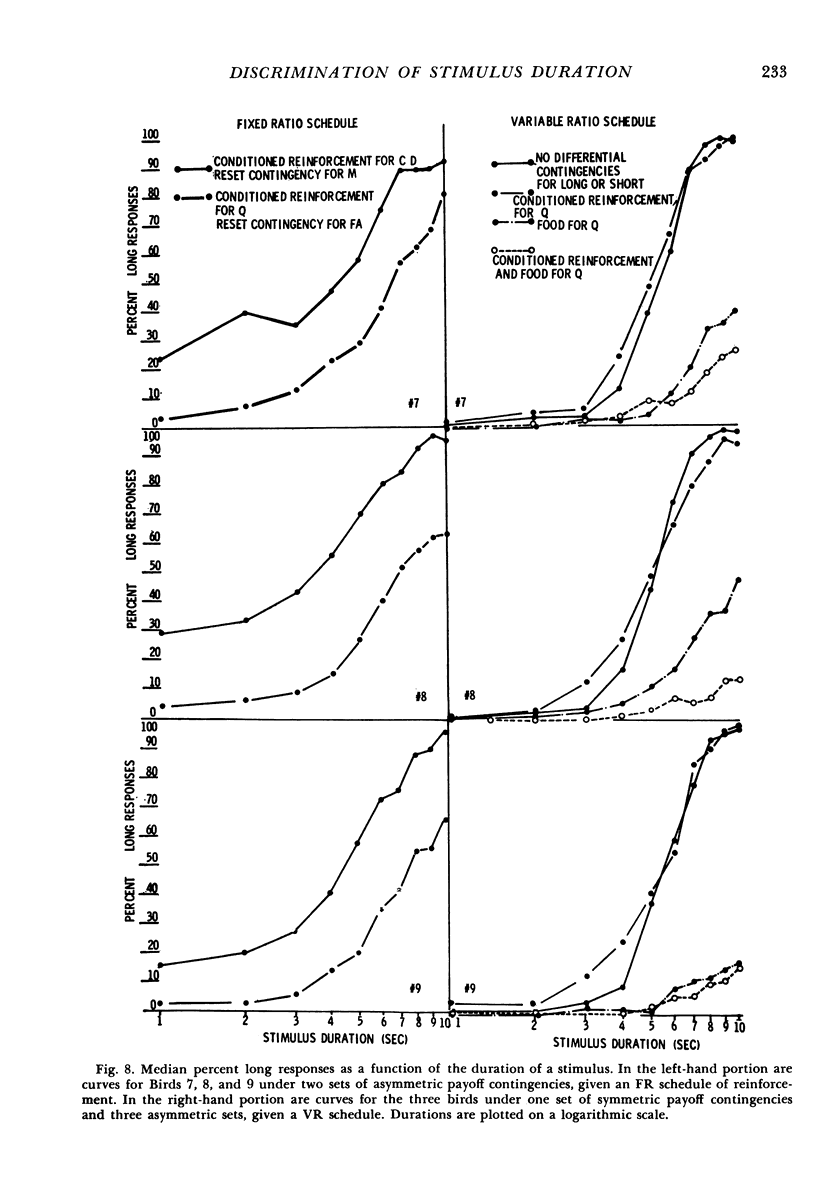Abstract
Pigeons were trained to discriminate the duration of a stimulus. One response in a psychophysical choice situation was reinforced, given the immediately prior presentation of a stimulus duration in one class of durations called short durations, and the other response was reinforced given the immediately prior presentation of a stimulus duration in a second class called long durations. Durations of equal logarithmic difference from the cutoff, whether in the short or long class, yielded equal accuracy. Accuracy was a function not only of the properties of the stimuli to be discriminated, but also of the experimental contingencies used. Accuracy was greater in variable-ratio than in fixed-ratio schedules of reinforcement of the discriminative responses, and was lower at the beginning than later in individual fixed ratios. Proportion of short or long responses (response bias) was affected by sequential dependencies among long and short durations and was effectively controlled through the use of asymmetric reinforcement and fixed-ratio contingencies.
Full text
PDF















Selected References
These references are in PubMed. This may not be the complete list of references from this article.
- CUMMING W. W., BERRYMAN R. Some data on matching behavior in the pigeon. J Exp Anal Behav. 1961 Jul;4:281–284. doi: 10.1901/jeab.1961.4-281. [DOI] [PMC free article] [PubMed] [Google Scholar]
- DEWS P. B. The effect of multiple S delta periods on responding on a fixed-interval schedule. J Exp Anal Behav. 1962 Jul;5:369–374. doi: 10.1901/jeab.1962.5-369. [DOI] [PMC free article] [PubMed] [Google Scholar]
- Dews P. B. The effect of multiple S periods on responding on a fixed-interval schedule: IV. Effect of continuous S with only short S probes. J Exp Anal Behav. 1966 Mar;9(2):147–151. doi: 10.1901/jeab.1966.9-147. [DOI] [PMC free article] [PubMed] [Google Scholar]
- Dews P. B. The effect of multiple S-delta periods on responding on a fixed-interval schedule: 3. Effect of changes in pattern of interruptions, parameters and stimuli. J Exp Anal Behav. 1965 Nov;8(6):427–435. doi: 10.1901/jeab.1965.8-427. [DOI] [PMC free article] [PubMed] [Google Scholar]
- FERSTER C. B. Intermittent reinforcement of matching to sample in the pigeon. J Exp Anal Behav. 1960 Jul;3:259–272. doi: 10.1901/jeab.1960.3-259. [DOI] [PMC free article] [PubMed] [Google Scholar]
- GOLDIAMOND I. SOCIAL FACTORS AND DISORDERS OF COMMUNICATION. RESPONSE BIAS AND PERCEPTUAL COMMUNICATION. Res Publ Assoc Res Nerv Ment Dis. 1964;42:334–363. [PubMed] [Google Scholar]
- GREEN D. M. CONSISTENCY OF AUDITORY DETECTION JUDGMENTS. Psychol Rev. 1964 Sep;71:392–407. doi: 10.1037/h0044520. [DOI] [PubMed] [Google Scholar]
- NEVIN J. A., CUMMING W. W., BERRYMAN T. Ratio reinforcement of matching behavior. J Exp Anal Behav. 1963 Apr;6:149–154. doi: 10.1901/jeab.1963.6-149. [DOI] [PMC free article] [PubMed] [Google Scholar]
- Pliskoff S. S., Goldiamond I. Some discriminative properties of fixed ratio performance in the pigeon. J Exp Anal Behav. 1966 Jan;9(1):1–9. doi: 10.1901/jeab.1966.9-1. [DOI] [PMC free article] [PubMed] [Google Scholar]
- REYNOLDS G. S., CATANIA A. C. Temporal discrimination in pigeons. Science. 1962 Jan 26;135(3500):314–315. doi: 10.1126/science.135.3500.314. [DOI] [PubMed] [Google Scholar]
- REYNOLDS G. S. TEMPORALLY SPACED RESPONDING BY PIGEONS: DEVELOPMENT AND EFFECTS OF DEPRIVATION AND EXTINCTION. J Exp Anal Behav. 1964 Nov;7:415–421. doi: 10.1901/jeab.1964.7-415. [DOI] [PMC free article] [PubMed] [Google Scholar]
- RISLEY T. GENERALIZATION GRADIENTS FOLLOWING TWO-RESPONSE DISCRIMINATION TRAINING. J Exp Anal Behav. 1964 Mar;7:199–204. doi: 10.1901/jeab.1964.7-199. [DOI] [PMC free article] [PubMed] [Google Scholar]
- Reynolds G. S. Discrimination and emission of temporal intervals by pigeons. J Exp Anal Behav. 1966 Jan;9(1):65–68. doi: 10.1901/jeab.1966.9-65. [DOI] [PMC free article] [PubMed] [Google Scholar]
- Rilling M. Number of responses as a stimulus in fixed interval and fixed ratio schedules. J Comp Physiol Psychol. 1967 Feb;63(1):60–65. doi: 10.1037/h0024164. [DOI] [PubMed] [Google Scholar]
- WALLACE M., RABIN A. I. Temporal experience. Psychol Bull. 1960 May;57:213–236. doi: 10.1037/h0041410. [DOI] [PubMed] [Google Scholar]


